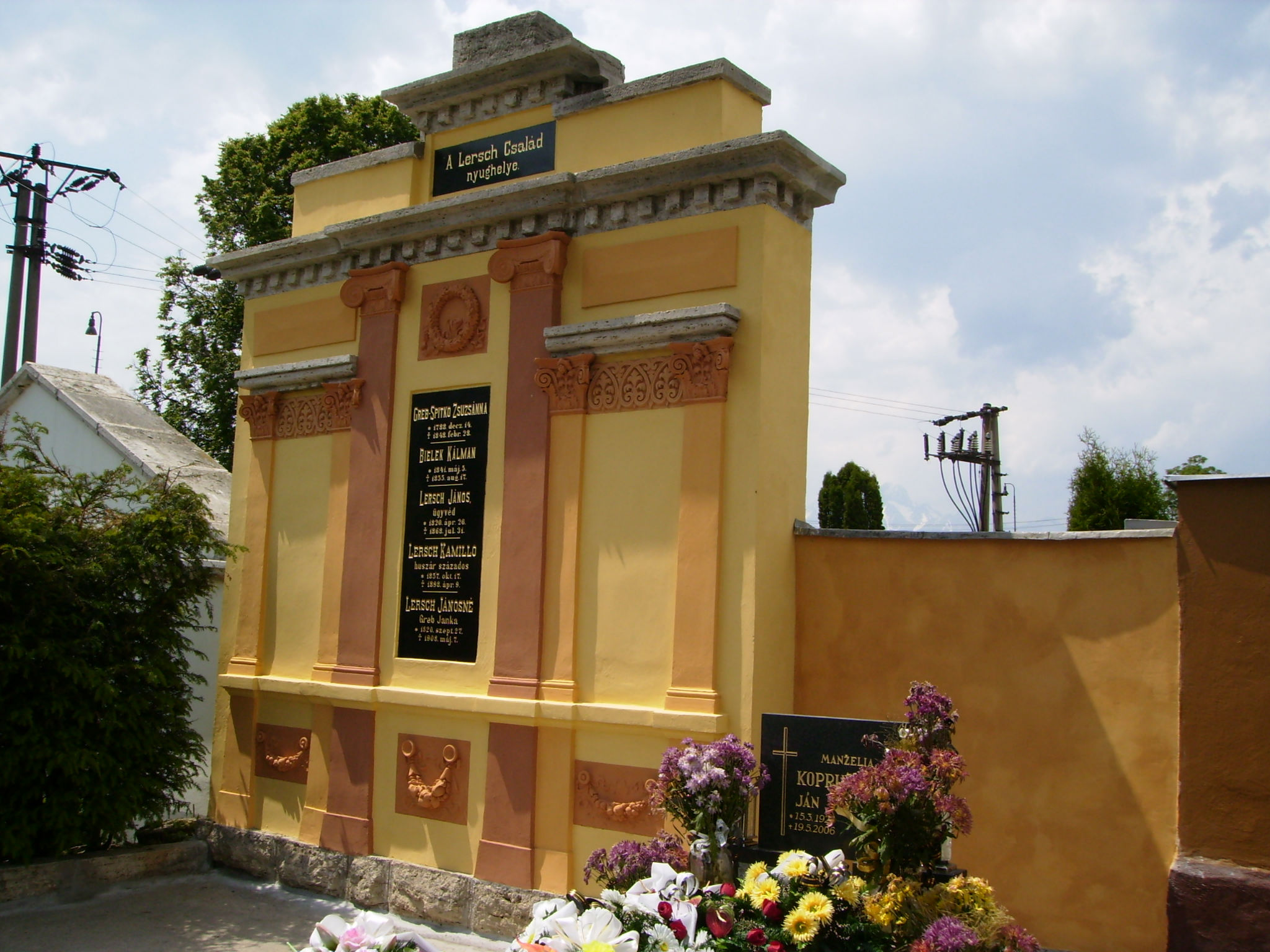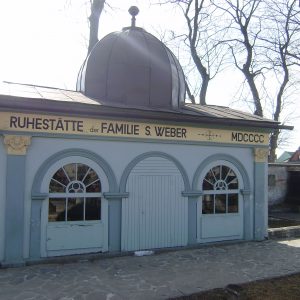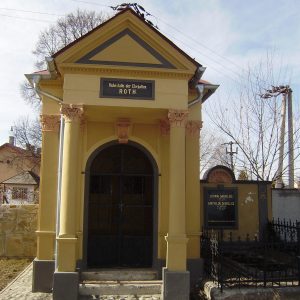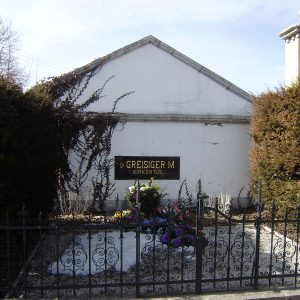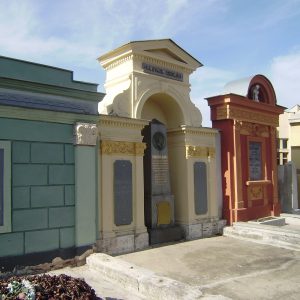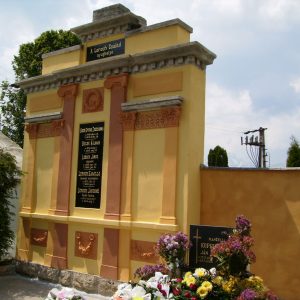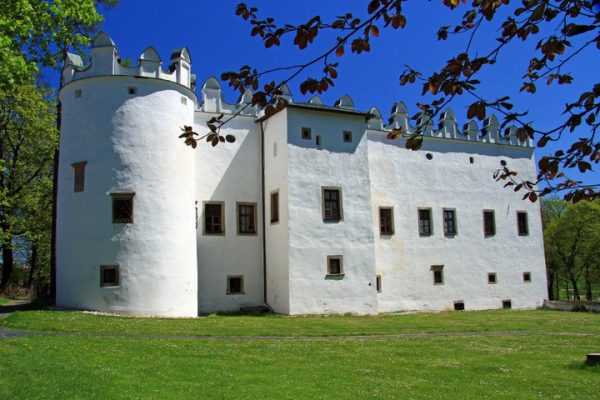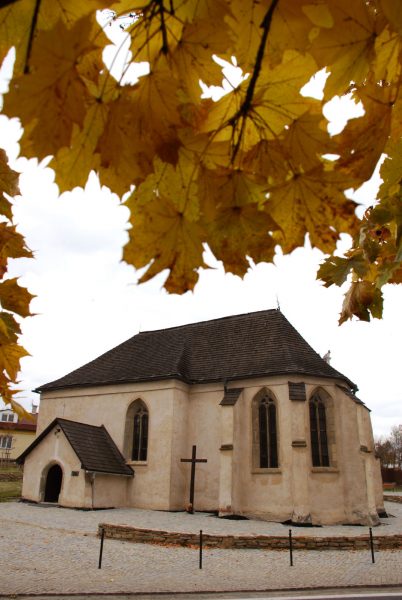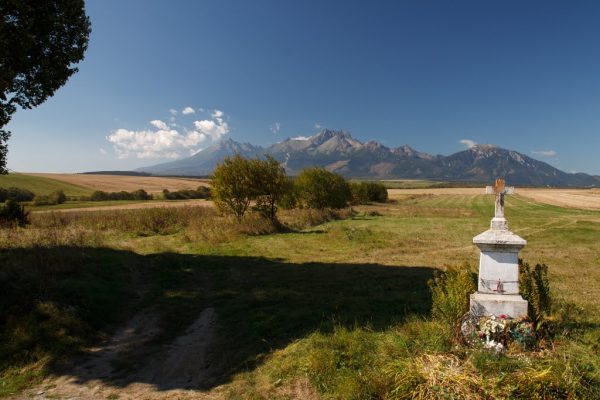16. Historický cintorín
![]() Najstarší cintorín, ktorý sal nachádzal pri Kostole sv. Antona – pustovníka sa nezachoval. Terajší cintorín zriadil mestský magistrát v roku 1778. V roku 1991 bol zväčšený – a na novej časti bol postavený Dom smútku .
Najstarší cintorín, ktorý sal nachádzal pri Kostole sv. Antona – pustovníka sa nezachoval. Terajší cintorín zriadil mestský magistrát v roku 1778. V roku 1991 bol zväčšený – a na novej časti bol postavený Dom smútku .
V starej časti cintorína sa nachádzajú náhrobky a krypty významných osobností mesta . Odpočíva tu Samuel Weber, Dr. Greisiger, ktorý projektoval aj dnes už neexistujúcu cintorínsku brezovú alej z konca 19. storočia. Dr. Weisz, Ludvigh. Významní podnikatelia Reich, Roth, Gretzmacher, Szimonisz, Hoffman, Greb. Od staršej vstupnej brány napravo sa nachádza niekoľko hrobov kňazov Jozefa Vojtasa, Štefana Vaverčáka, Begalu, Pollaka, Varsányiho a Ratzenbergera.
Možno tu nájsť aj hroby dvoch nemeckých vojakov, ktoré boli nedávno exhumované a premiestnené.
Svoj unikátny príbeh má aj neoznačená hrobová mohyla, kde je pochovaný gróf Peter Rottenburg, ktorý bol zastrelený pri útoku cisárskych vojsk na Spišskú Belú v júli 1849. Jeho náhrobný kameň, ktorý sa už nezachoval, mal nápis „Peter Rottenburg, gróf z Nugentu, cisársky veliteľ a adjunt 30 Lin. Infantérie regimentu našiel 7. júla 1849 čestnú smrť.“ Za smrť grófa mali Beľania vdove Rottenburgovej zaplatiť odškodné 1000 florénov. V roku 1835 zriadilo mesto nový cintorín pre svoju kolóniu v Ždiari, na vlastnom majetku, lebo Ždiarania žiadali za 1 miesto na pochovanie 1 zosnulého zo spišskobelianskej kolónie pri Ždiari 25 zlatých. Dnes je tento cintorín nefunkčný.
16. Cemetery
![]() The oldest cemetery near the church of St. Anthony the Great was not preserved. The town’s magistrate established the present-day cemetery in 1778. In 1991, it was extended – and in its new section, the House of Grief was erected.
The oldest cemetery near the church of St. Anthony the Great was not preserved. The town’s magistrate established the present-day cemetery in 1778. In 1991, it was extended – and in its new section, the House of Grief was erected.
In the old part of the cemetery, we find graves and crypts of important personalities who lived in the town. Among those who have found their final resting place here are Samuel Weber, Dr. Greisiger, who planted an alley of birches in the cemetery in the late 19th century that has since been removed, and Dr. Ludvigh Weisz. Others who are buried here include such important entrepreneurs as Roth, Gretzmacher, Szimonisz, Hoffman and Greb. Not far from the old entrance gate, on the right side, we can find a number of clergymen’s graves, for example those of Jozef Vojtas, Štefan Vaverčák, Begal, Pollak Varsány and Ratzenberg. The bodies of two German soldiers were also buried here, but have since been exhumed and moved.
The unmarked burial mound where Count Peter Rottenburg is buried has a unique story. He was shot during the attack of the imperial army on Spišská Belá in July of 1849. His gravestone, which has not been preserved, read “Peter Rottenburg, count of Nugent, imperial captain and adjunct of the 30th infantry regiment, found an honorable death on July 7, 1849.“ It is rumored that the local inhabitants were to pay a compensation of 1000 Florins to the count’s widow after his death.
In 1835, the city established a new cemetery for its settlement in Ždiar on its own territory, since the town charged Spišská Belá 25 guldens for each burial plot. Today, this cemetery is no longer functional.
16. Der Friedhof
![]() Der älteste Friedhof, der sich an der Kirche des heiligen Eremiten Antonius befand, hat sich nicht erhalten. Den jetzigen Friedhof hatte der Magistrat 1778 angelegt. 1991 wurde er vergrößert, und auf dem neuen Teil errichtete man das Haus der Trauer. Im alten Friedhofsteil befinden sich die Gräber und Krypten bedeutender Persönlichkeiten der Stadt. Hier ruhen Samuel Weber, Dr. Greisiger, der auch die heute nicht mehr bestehende Birkenallee des Friedhofs vom Ende des 19. Jahrhunderts projektierte, Dr. Weisz, Ludvigh, ferner die bedeutenden Unternehmer Reich, Roth, Gretzmacher, Szimonisz, Hoffman, Greb. Rechts vom älteren Friedhofstor befinden sich mehrere Gräber der Geistlichen Jozef Vojtas, Štefan Vaverčák, Begal, Pollak, Varsány und Ratzenberger.
Der älteste Friedhof, der sich an der Kirche des heiligen Eremiten Antonius befand, hat sich nicht erhalten. Den jetzigen Friedhof hatte der Magistrat 1778 angelegt. 1991 wurde er vergrößert, und auf dem neuen Teil errichtete man das Haus der Trauer. Im alten Friedhofsteil befinden sich die Gräber und Krypten bedeutender Persönlichkeiten der Stadt. Hier ruhen Samuel Weber, Dr. Greisiger, der auch die heute nicht mehr bestehende Birkenallee des Friedhofs vom Ende des 19. Jahrhunderts projektierte, Dr. Weisz, Ludvigh, ferner die bedeutenden Unternehmer Reich, Roth, Gretzmacher, Szimonisz, Hoffman, Greb. Rechts vom älteren Friedhofstor befinden sich mehrere Gräber der Geistlichen Jozef Vojtas, Štefan Vaverčák, Begal, Pollak, Varsány und Ratzenberger.
Auch die Gräber zweier deutscher Soldaten kann man hier finden, die unlängst exhumiert und umgebettet wurden.
Seine einzigartige Geschichte hat auch der unmarkierte Grabhügel, in dem Graf Peter Rottenburg bestattet ist, welcher im Juli 1849 bei einem Angriff der kaiserlichen Truppen auf Zipser Bela erschossen wurde. Sein Grabstein, der nicht mehr erhalten ist, trug die Aufschrift „Peter Rottenburg, Graf von Nugent, kaiserlicher Befehlshaber und Adjunkt des 30. Infanterieregiments, fand am 7. Juli 1849 einen ehrenvollen Tod.“ Für den Tod des Grafen sollten die Einwohner von Zipser Bela seiner Witwe 1000 Florentiner Entschädigung zahlen. 1835 legte die Stadt auf eigenem Grund und Boden in Ždiar einen neuen Friedhof für ihre Kolonie an, denn die Einwohner von Ždiar forderten für einen Grabplatz bei Ždiari pro Verstorbenen aus der Kolonie von Zipser Bela 25 Gulden. Heute ist dieser Friedhof nicht mehr in Betrieb.
16. Cmentarz
![]() Nie zachował się najstarszy cmentarz, który znajdował się przy kościele Św. Antoniego Pustelnika. Obecny cmentarz założony został przez władze miejskie w 1778 roku. Powiększono go w 1991 r., a w nowej części wybudowano Dom żałobny.
Nie zachował się najstarszy cmentarz, który znajdował się przy kościele Św. Antoniego Pustelnika. Obecny cmentarz założony został przez władze miejskie w 1778 roku. Powiększono go w 1991 r., a w nowej części wybudowano Dom żałobny.
W starej części cmentarza znajdują się nagrobki i krypty znaczących mieszkańców miasta. Pochowani są tutaj Samuel Weber, dr Greisiger, który pod koniec XIX wieku zaprojektowal nieistniejącą dziś cmentarną aleję brzozową, dr Weisz, Ludvigh, a także znani fabrykanci Reich, Roth, Gretzmacher, Szimonisz, Hoffman, Greb. Na prawo od starej bramy wejściowej znajduje się kilka grobów miejscowego duchowieństwa Jozefa Vojtasa, Štefana Vaverčáka, Begalu, Pollaka, Varsányiego i Ratzenbergera.
Są tam też groby dwóch niemieckich żołnierzy, których ciała niedawno ekshumowano i przeniesiono. Ciekawa jest historia bezimiennej mogiły, w której pochowany jest hrabia Peter Rottenburg, zastrzelony w lipcu 1849 roku podczas ataku wojsk cesarskich na Białą Spiską. Na kamieniu nagrobnym, który się nie zachował, widniał napis: „Peter Rottenburg, hrabia von Nugent, dowódca wojsk cesarskich i adiunt 30 Pułku Piechoty (Lin. Infanterie regiment) zginął śmierią bohatera 7 lipca 1849 roku“. Mieszkańcy Białej za śmierć księcia mieli wypłacić wdowie odszkodowanie w wysokości 1000 florenów.
W roku 1835 miasto założyło na własnym terenie nowy cmentarz dla swojej kolonii w Żdiarze, ponieważ mieszkańcy Żdiaru żądali 25 złotych za pochowanie 1 zmarłego z tej kolonii. Dziś cmentarz ten jest już zamknięty.

